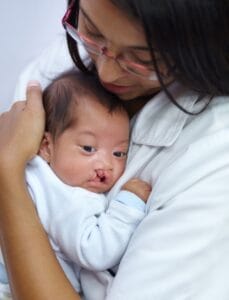 Dental practitioners are vital for diagnosing and classifying cleft lip and palate. With this knowledge, parents with affected babies can better prepare the latter for surgery. But, categorising the anatomy and severity of each cleft lip is challenging. This is why consistency is important for the classification of the condition.
Dental practitioners are vital for diagnosing and classifying cleft lip and palate. With this knowledge, parents with affected babies can better prepare the latter for surgery. But, categorising the anatomy and severity of each cleft lip is challenging. This is why consistency is important for the classification of the condition.
A cleft lip is often noticed at the 20-week screening scan during pregnancy. Cleft palate is more difficult to detect via ultrasound. If neither are visible on the scan, they may be diagnosed after birth.[i]
As cleft lip and palate can encompass a wide range of severity, there are many challenges associated with the condition. Some of these are instant – affected infants are unable to make a tight seal for feeding. Later problems can include:
Surgery is therefore vital to correct the deformity.
But before this, the cleft lip and palate must be classified to help treatment planning. This enables the patient / parents to name, grade, discuss and remember the clinical details.[ii] However, there are many classification systems to choose from.
The structure of the cleft lip and palate is used as the base for classification systems. Some may also look at the embryonic development. Among the more widely used systems are:
Each of these has a unique protocol. For instance, Kernahan has a ‘striped Y’ diagram to visualise the extent and location of the cleft. But each method has limitations – Veau does not account for the severity of the defect, for example.
In contrast, the LAHSHAL classification is more comprehensive for clinicians. In practice it allows a cleft to be easily coded for computer use. LAHSHAL splits the mouth into seven parts, each corresponding to a letter in its name. For maximum coverage, LAHSHAL can describe over 12,000 combinations.[iii]
More recently, a study aimed to develop a new classification system. It focused on nasal deformities in infants with cleft lap and palate. As other classifications omit nasal deformities, this offered a more in-depth solution. The study assessed the symmetry of the septum, projection of the nasal tip, and the shape of the nostrils.[iv] Using a range from moderate to severe, the findings demonstrated a strong consistency among clinicians, with excellent agreement across the survey.[v]
By following such a protocol, clinicians can better evaluate the efficacy of different treatment approaches whilst also identifying potential areas for refinement.v This in turn can transform the life of a cleft lip and palate patient, supporting them in living without many of the complications associated with a cleft lip and palate and secondary nasal deformity. It is, therefore, essential for clinicians to retain consistency in the classifications as this means consistency for the patient and improved surgical outcomes.
Pre-treatment preparation is essential for achieving the desired outcome. Clinicians should recommend the DynaCleftâ system from Total TMJ for cleft lip and palate patients. A collaborative result developed by plastic surgeons, orthodontists and cleft palate teams, the system gently guides and supports facial tissues, improving nasal symmetry and better positioning the cleft lip and palate for optimal surgical results.

The correct classification of cleft lip and palate is integral for optimising treatment outcomes. Having consistency and staying up to date on the latest research allows clinicians to support affected patients to the highest level, preparing them an improved quality of life.
[i] NHS (2019). Overview – Cleft lip and palate. [online] NHS. Available at: https://www.nhs.uk/conditions/cleft-lip-and-palate/.
[ii] Singh, D., Bastian, T., Singh, M. and Sharma, P. (n.d.). Classification Systems for Orofacial Clefts. [online] doi:https://doi.org/10.5005/jp-journals-10037-1035.
[iii] Uhbristol.nhs.uk. (2020). The South West Cleft Service. [online] Available at: https://www.uhbristol.nhs.uk/patients-and-visitors/your-hospitals/bristol-royal-hospital-for-children/what-we-do/the-south-west-cleft-service/information-and-leaflets/information/.
[iv] Mejia, M., Bernal, I., Cordero, J.P., Bercu, C., Rohan Policherla and Steinberg, J.P. (2025). A Proposed Nasal Deformity Classification System for Infants With Cleft Lip and Palate. Journal of Craniofacial Surgery. [online] doi:https://doi.org/10.1097/scs.0000000000011151.
[v] Health, W.K. (2025). New classification system proposed for infants with nasal deformity in cleft lip and palate. [online] Medicalxpress.com. Available at: https://medicalxpress.com/news/2025-05-classification-infants-nasal-deformity-cleft.html [Accessed 11 Jul. 2025].